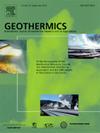Deep learning–based three-dimensional terrestrial temperature modeling throughout Japan incorporating multiple crustal properties and spatial correlation with an application to critical point distribution
IF 3.9
2区 工程技术
Q3 ENERGY & FUELS
引用次数: 0
Abstract
One of the most fundamental and essential issues for both ordinary and supercritical geothermal power generation is to specify hot zones with sufficient temperature and volume via the three-dimensionally estimated terrestrial temperature distribution from the surface to great depths over a wide area using well-temperature logging data. However, the amounts and locations of such data are generally limited, and target regions and depth ranges for temperature-at-depth predictions are generally narrow, and the targeted upper range of the temperature prediction is mostly lower than 250 °C. To overcome these problems, this study aims to enable an extensive temperature estimation by applying deep neural network (DNN) and neural kriging (NK) for targeting all of Japan. To supplement the temperature data, multiple crustal properties from geophysical and geochemical data, such as the Curie point depth, water quality of hot springs, active volcano distribution, and surface geology, are incorporated into the DNN and NK. The interpolation and extrapolation accuracies of the temperature logging data are evaluated using the holdout method, and the superiority of NK, especially for data extrapolation, is confirmed. Features of the NK temperature distribution that enable estimation of the temperature down to great depths with extremely sparse temperature logging data are determined and characterized. Using a three-dimensional temperature model, the distribution of the critical point of water is delineated throughout Japan and the expected resource densities are calculated under the condition of power generation using a steam flash system over 30 years. The results specify promising areas of supercritical geothermal resources, primarily located around typical active volcanoes, and large production power from a relatively shallow depth range over the long term.
基于深度学习的全日本陆地三维温度模型,结合多种地壳性质和空间相关性,并应用于临界点分布
无论是普通地热发电还是超临界地热发电,最基本、最本质的问题之一就是利用井温测井资料,通过在大范围内从地表到深层的三维估计地球温度分布,确定具有足够温度和体积的热区。然而,此类数据的数量和位置通常有限,深度温度预测的目标区域和深度范围通常很窄,温度预测的目标上限大多低于250°C。为了克服这些问题,本研究旨在通过应用深度神经网络(DNN)和神经克里格(NK)对整个日本进行广泛的温度估计。为了对温度数据进行补充,我们将居里点深度、温泉水质、活火山分布、地表地质等地球物理和地球化学资料中的多种地壳性质纳入DNN和NK中。利用holdout法对温度测井资料的插值和外推精度进行了评价,证实了NK法在数据外推方面的优越性。确定并描述了NK温度分布的特征,这些特征可以用极稀疏的温度测井资料估计深至深的温度。利用三维温度模型,圈定了日本各地水临界点的分布,并计算了蒸汽闪蒸系统30年发电条件下的预期资源密度。研究结果明确了超临界地热资源有潜力的地区,这些地区主要位于典型的活火山周围,并且在相对较浅的深度范围内长期具有较大的生产能力。
本文章由计算机程序翻译,如有差异,请以英文原文为准。
求助全文
约1分钟内获得全文
求助全文
来源期刊

Geothermics
工程技术-地球科学综合
CiteScore
7.70
自引率
15.40%
发文量
237
审稿时长
4.5 months
期刊介绍:
Geothermics is an international journal devoted to the research and development of geothermal energy. The International Board of Editors of Geothermics, which comprises specialists in the various aspects of geothermal resources, exploration and development, guarantees the balanced, comprehensive view of scientific and technological developments in this promising energy field.
It promulgates the state of the art and science of geothermal energy, its exploration and exploitation through a regular exchange of information from all parts of the world. The journal publishes articles dealing with the theory, exploration techniques and all aspects of the utilization of geothermal resources. Geothermics serves as the scientific house, or exchange medium, through which the growing community of geothermal specialists can provide and receive information.
 求助内容:
求助内容: 应助结果提醒方式:
应助结果提醒方式:


